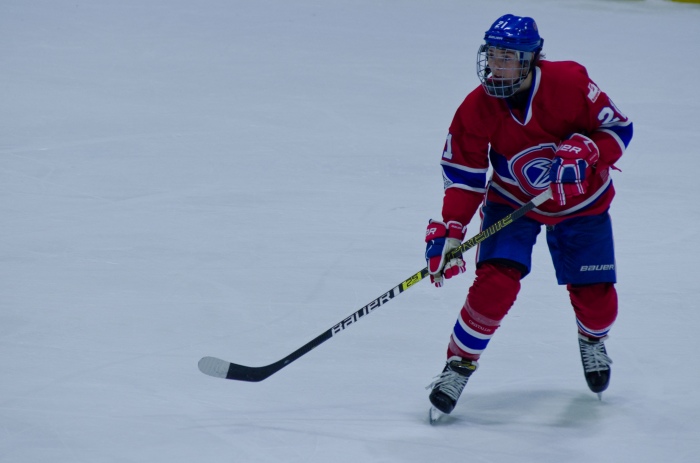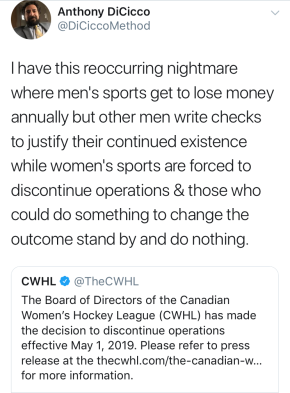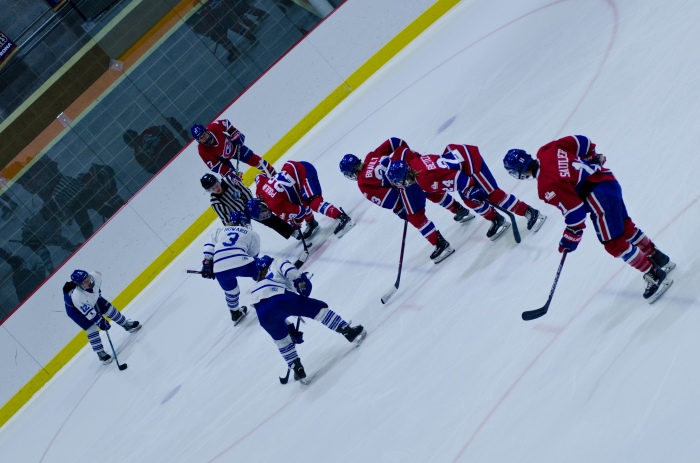
Hilary Knight playing for Les Canadiennes de Montreal in February 2019. Photo by Courtney Szto.
Co-Authored by Brett Pardy and Courtney Szto
*Note: We tend not to refer to the CWHL in the past tense in these posts because…it just feels wrong.*
In 2001, Japan created a reality TV show titled, The Tigers of Money. This venture capitalist show was the impetus for the Dragons’ Den series that has been re-created in 30 countries around the world. The American version, Shark Tank, debuted in 2009. If you haven’t seen the show before, entrepreneurs go on the show and make a pitch for their business idea in the hopes that one of the panelists of potential investors will throw some capital their way.
Now, imagine someone going on Shark Tank and pitching a business that had the ability to draw almost 5 million viewers in Canada and 3 million viewers in the US (the most ever for NBC’s late-night time slot). This business has seen membership grow 20% in Canada and 38% in America since 2006. This product already has a cult-like following but just needs some extra capital to get it to the next level. The product itself is young, able-bodied, well-educated, predominantly white women, who kick ass (a product that has proven itself lucrative in many other industries). Then imagine that the entire panel passes on the opportunity to support this product.
This is the story of women’s professional hockey.
On season 4 of Shark Tank, Aaron Krause, founder of the Scrub Daddy sponge went on the show struggling to bring in $100,000 in revenues, but Lori Greiner invested in his company because she saw potential in a “smiley-faced sponge.” A smiley…faced…sponge. And, she was right because as of 2017 the Scrub Daddy brought in $75 million in revenue and is evidently “America’s Favorite Sponge.” In Season 5, Mark Cuban put up $2 million (basically half the operating budget for the CWHL) to support a “live horror-entertainment company” and that investment brings in “half a million dollars in annual profit.” The point of this Dragons’ Den/Shark Tank tangent is to emphasize that business investments are about all about potential and they are all inherently risky; yet, no one has been willing to invest in women’s hockey despite its ability to consistently pack stadiums and draw eyes every time the Winter Olympics rolls around.
* * *
A common response to the slow professionalization of women’s hockey is that women pro hockey players do not deserve more than the pitiful stipends they receive because they are not generating sufficient revenue to support higher salaries. Case in point, here was another common “critique” directed at Anissa Gamble when she tweeted about income disparity in men’s versus women’s hockey:
Do your games bring in millions of dollars in revenue? Do you have millions of dollars in endorsements? Hard to pay millions in salary with no money.
Such thinking relies upon the simplistic economic logic that the “invisible hand” of the free market provides returns based on market demand. In other words, you get what you deserve. If you make millions it’s because you deserve millions. If you make $3,000 it’s because your talent, dedication, and value only warrant $3,000. The problem, unfortunately, is that the economic environment we live and operate in is anything but “free.” We routinely support and bail out businesses that are either unproven or failing. The 2008 government funded bail out for the U.S. auto industry (almost $81 billion over 6 years) is the quintessential example of a market that operates with constant interference. Even companies seen as “successful” like Netflix operate in significant debt based upon the promise of future returns. Yet, every time Netflix announces a new series (a seemingly weekly occurrence), their Twitter replies are not filled with people demanding they operate within their means.
In the world of hockey this looks like the Florida Panthers receiving $86 million in public funds (drawn from tourism taxes) to avoid bankruptcy. It also looks like all of the effort required to keep the Arizona Coyotes in Glendale:
The city borrowed about $180 million to build the arena in 2003 and spent another $45 million to try to keep the team in the arena after the owner filed for bankruptcy and new owners were sought. The city then paid the new ownership $15 million to manage the arena in the first few years. The city is still paying off the arena debt, at about $13 million a year, until 2033.
That means the Arizona Coyotes have received in excess of $253 million from public coffers just to keep them afloat. The $13 million they receive from the city every year to pay off the arena debt is just slightly less than 4x the operating budget of the CWHL. So what did the Panthers and Coyotes do to “deserve” such charity investment? The truth of the matter is the only thing they did was be fortunate enough to exist in men’s professional sports. When women’s sports ventures fail they are used as proof that women’s sports is undeserving of financial investment. When men’s sports ventures fail they are framed as merely the cost of doing business. If the market truly dictated what people “deserved” then the Arizona Coyotes and Florida Panthers would no longer be part of the NHL. We control the market when we want to.

Risky investment in men’s pro sports remains the norm. Just this February, Tom Dundon invested $250 million in the struggling new Alliance of American Football (AAF), a league with a CBS television partnership (A struggling league with a TV contract? But we thought you had to earn TV sponsorship, work your way up from online streaming…🙄). Despite not having a competitor league, the AAF paid players $70,000 so they could dedicate themselves full time to football and not have to take on secondary jobs. However, the league folded less than a season in, costing Dundon an estimated $70 million in just two months. Other investors in this failed league included Peter Thiel (co-founder of PayPal) and Barstool Sports’ owners, the Chernin Group.
The above investment may sound absurd, but it’s indicative of the type of funding needed to attempt a successful sports league. World Wrestling Entertainment (WWE) chairman Vince McMahon is planning to invest $500 million into yet another minor league for football, scheduled to begin play next year. Major League Soccer (MLS), which lost over $250 million dollars from its debut in 1996 to 2001, actually folded for a few days. Five years later, the league signed an $8 million annual television deal, despite the fact “television ratings have declined since the inaugural season.” The MLS also signed a $15 million per year sponsorship with Adidas. The league’s current television deal is $90 million per year (Side note: if we wanted to pay 6 CWHL teams, $50,000 per player [which is a low ball amount to live in a major Canadian city] for a roster of 23, it would cost just under $7 million in player salaries). As more television promotion means more exposure, ad revenues have also spiked. Jersey ads now can net each team up to $4 million, significant for a league with a team salary cap of $4.035 million. While you can argue that men’s soccer has always been popular, this was not true in North America. A prior attempt at a major professional league, the North American Soccer League, crashed in the mid-1980s. Today, the league remains low profile in the professional men’s soccer landscape. Importantly, the league’s growth represents the investment necessary to get MLS into the playing field for decent attention and media deals.
As the AAF and the MLS illustrate, investing in sports is a risky business. But the public often bears this risk, because having men’s sports teams are seen as important social capital for cities. This logic applies below the major leagues as well. Abbotsford, British Columbia housed the Calgary Flame’s AHL team from 2009-14, the Heat. Desperate to fill the city’s new arena (which cost $64 million and still sits largely empty), Abbotsford agreed to subsidize the team for any operating losses. This agreement ended up costing the city $12.7 million. Brampton, Ontario has a similar deal for the ECHL’s Brampton Beast. Even the neoliberal think tank, The Brookings Institute (a gentrification cheerleader), opposes subsidies for pro sports (much less minor league) teams and stadiums, concluding there is no economic benefit to having a team. Still, we do it.
Anissa Gamble got a lot of flack for bringing gender into what is presumed to be a revenue fight:
Exhibit A: When men get paid to walk the Victoria Secret runway and make what the Super Models make it will be about Equal opportunity people! Honestly this logic don’t make sense. Sorry, not sorry. [Side note: Ashley Mears’ book, Pricing Beauty, gives you an inside look at the modelling industry and men, on average, tend to have longer careers meaning they continue to earn money well after women’s earning potential is behind them. The fashion industry is also heavily male dominated when it comes to decision-making power. So stay in your lane, sir.]
Exhibit B: You can’t bring gender inequality to an argument like this without even showing the revenue the CWHL generates in comparison to the NHL
Exhibit C: Gender inequality?? Wow, you did not think things through before you made that statement.
But this is absolutely a gender issue! How does gender operate within the market and how is gender valued differently within that market? As The Ringer wrote about the failed AAF, “Most leagues fold because they cannot find a man with money in the bank,” and the stark reality is that men with money in the bank are awfully reluctant to support women’s hockey. But is this the only way? Is the viability and sustainability of women’s pro hockey all in the hands of some rich hero who comes to save the day? Is there an alternative to a Dragon’s Den style pitch for money?

Toronto Furies at Les Canadiennes de Montreal on Hockey Day in Canada 2019. Photo by Courtney Szto.
Collective ownership offers an alternative to the traditional “man with money in the bank” model. It’s the antithesis of how we have constructed life in Canada and the U.S. but it’s actually quite normal for European soccer clubs to be collectively owned by their fans. For example, FC Barcelona (the 4th most valuable sports team in the world) is collectively owned by 150,000 members who pay 141 Euros (approximately $211 CAD) annually to receive a share in the ownership of the team. That means they bring in approximately $31.6 million annually from membership dues alone. Real Madrid, the Green Bay Packers (NFL), and the Saskatchewan Roughriders (CFL) are other examples of publicly owned teams (Wiki list of fan owned teams here). Real Madrid is represented by 91,000 members who pay 123 Euros per year, and both the Packers and Roughriders shares sell for $250 each. The Roughriders place a limit on the number of voting shares any individual can buy but you can buy an unlimited number of non-voting shares.
Building off of Brett’s Myth #2 post about how leagues and teams come into formation, private ownership and investment are reflective of a society that has privileged the wealthy by letting them buy power, but this doesn’t mean that’s how we have to move forward:
Fan ownership in Germany and Spain goes back to the early years of the 20th century, when it was considered an unremarkable way to raise money for a team. (British teams originally had a similar structure, but eventually saw a shift to private ownership because there were no rules to stop one individual from buying up all the stock.) In the U.S., meanwhile, where the sports business evolved as mostly a way for local rich guys to promote their products (beer magnates were especially popular), only one prominent team followed the fan-owner model: the Green Bay Packers, who were set up in 1923 as a private non-profit, later adding a rule that no one individual could own more than a small percentage of shares. (Sports on Earth)
If everyone who tuned in to watch the 2019 Clarkson Cup final bought a share at the FC Barcelona price of $211 to support women’s hockey, that would result in just under $37 million to help run the entire league — not a team, like FC Barcelona is, but an entire league. Even if we bring that number down to only the 88,541 girls/women who are registered in organized hockey in Canada (per Hockey Canada’s 2016-2017 Annual Report) that’s still $18.682 million, five times more than the CWHL had to run its operations. This figure is also exclusive of any corporate sponsorships and media deals that the league would obviously receive in its next iteration (considering how interested folks have become in the last 10 days).
Would it work to collectively own a league as opposed to a team? We’re not entirely sure but the Mr. Money Bags method isn’t a guarantee either. It’s also a nice way to get people to buy into the future of their children because you wouldn’t just be supporting the women who need a place to play today, you would also be ensuring that tomorrow’s generation has a league to grow into. It would relieve the pressure of needing to find Mr. Money Bags and leave the majority of power in the hands of the players and management. The most successful co-op in Canada might be MEC (Mountain Equipment Co-Op) and they explain on their website: “We’re a co-op. That means we’re a little different than most outdoor gear stores. Everyone who shops here is a member and an owner, and our business structure is designed around values, not profit.” As players’ association rep, Karell Emard said on The Last Stretch Podcast (see below for a link), “You can come with a bag of money and have the worst attitude in the world and we’ll turn you away,” thus, co-operative ownership would enable a values first vision moving forward. This also doesn’t need to be a forever plan but could be an approach that transitions us into a better future. Collective ownership seems to match the ethos of women’s hockey — it’s always been a collective struggle, so why not engage in a collective future? The slate is clean and the women deserve better than what they have received previously, so maybe returning to the same well isn’t the best course of action (or at the very least, isn’t the only option).
* * *
What was particularly jarring about the abrupt closure of the CWHL was that something 12 years in the making could disappear as quickly as it did. It’s a valuable reminder that progress is not guaranteed. American author, Rebecca Solnit (2014) warns us that optimism for the future can often create grounds for inaction. Hope, on the other hand:
means another world might be possible, not promised or guaranteed. Hope calls for action; action is impossible without hope….To hope is to give yourself the future, and that commitment to the future makes the present inhabitable. (Solnit, 2005)
The solidarity demonstrated by the women of the (ugh, former) CWHL is truly inspiring. All of the significant gains made in society have been made collectively, so whatever happens next, know that we have been presented with a rare opportunity to turn hope into action and to give ourselves to a future that is well overdue.
To learn more about the closure of the CWHL check out these podcast episodes:
Read the rest of the Myth Busting series:
- Part 1: “No one wants to watch women’s hockey“
- Part 2: “Time is all you need“



Pingback: Myth Busting, Part 1: “No one wants to watch women’s hockey” | Hockey in Society
Pingback: Guest Post: North American women’s ice hockey players struggle for a league of their own | Hockey in Society
Pingback: Ouellette-Poulin Hockey: The love fest continues | Hockey in Society
Pingback: Women’s hockey and the never-ending call for more evidence | Hockey in Society / Hockey dans la société
Pingback: Myth Busting, Part 4: “We need a new model” | Hockey in Society / Hockey dans la société